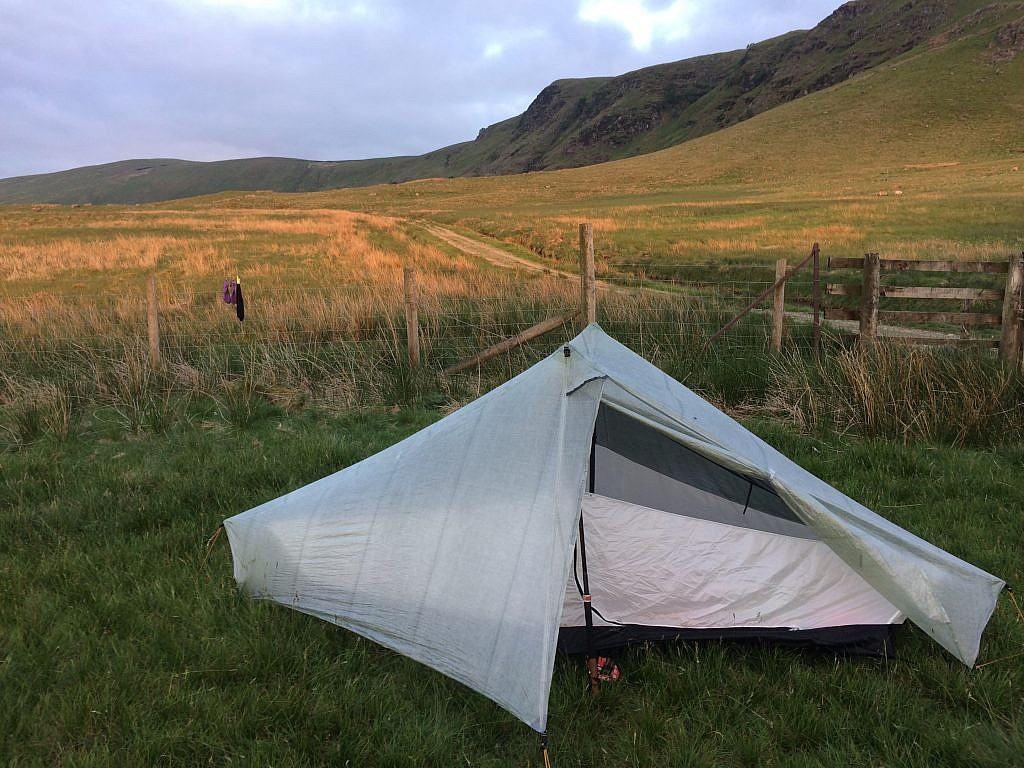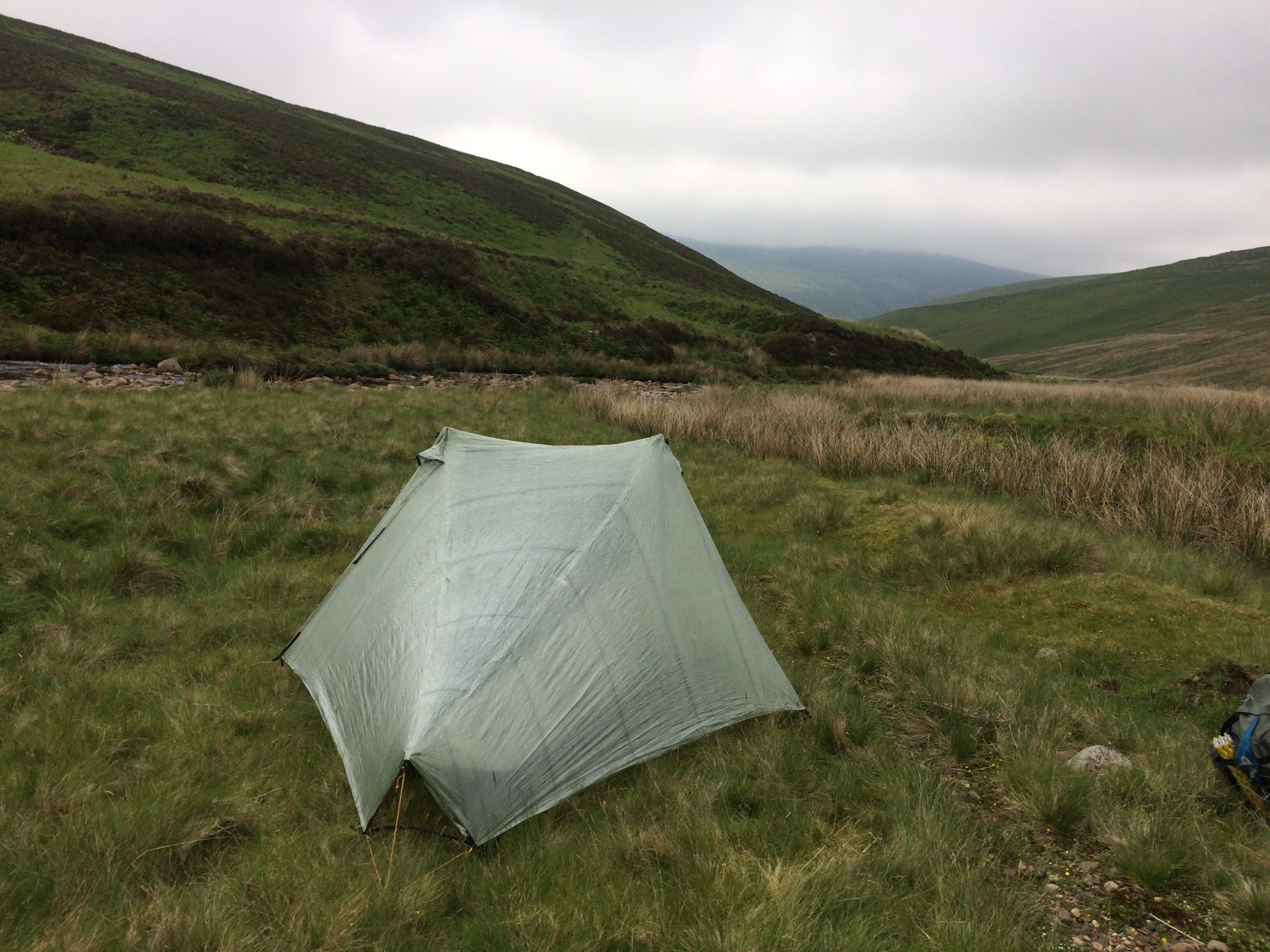
The Tarptent Notch Li is a fantastic ultra light shelter for the solo thru-hiker looking for simplicity and durability, while not sacrificing comfort. Made of dynamee, the Notch Li is essentially waterproof. It sets up super fast with the use of trekking poles that remain outside the living space. The twin-peaked catenary ridgelines add rigidity in the wind and rain as well as create an enormous living space with two entryways and two vestibules.
Notch Li is my choice for a home away from home.
I bought my first Tarptent when I walked the John Muir Trail in 2012. The single-walled Moment was the envy of all my hiking friends because it set up literally in seconds and was roomy with an enormous vestibule. I have since added an inside layer provided by Tarptent to alleviate condensation, but when I planned to walk on the soggy Coast-to-Coast, I decided to upgrade to something more reliably dry.

The success of the Notch Li begins with its fabric. Formerly known as cuben fiber, dynamee is considered the most revolutionary material used today to make outdoor gear. It’s technically classified as ultra-high-molecular-weight polyethylene. The fiber has low density that allows for high load dispersion. Fifteen times stronger than steel and extremely light, it is the strongest fiber in the world.
But wait, there’s more! It’s also waterproof, resistant to UV light and chemicals, and is extremely durable.
But that doesn’t mean you can just stuff the Notch Li in your pack. You need to handle it with care by rolling it into its dynamee bag. The feel is a cross between taffeta and rice paper, but I endured absolute downpours and there was not one drop in my tent.

I opted for the partial solid interior made of silnylon which saves a bit of money on your purchase but I had a few other reasons for this choice. While dynamee is strong and waterproof, it’s translucent and I like a wee bit of privacy.
I also hike in places with blowing sand and heavy rainfall. The solid wall rises fairly high inside. It does cut down on views when supine, but it also keeps splash and detritus from finding its way through the no-see-um screen.
The partial solid silnylon interior adds a few more ounces, but I felt it was worth it. I did not purchase nor have I used a footprint due to the floor’s ruggedness, but I do choose my sites carefully.
The Notch Li sets up like a dream. It is a non-freestanding tent with each corner supported by carbon struts that create a triangle. You simply roll out the tent, stake down each end with the provided Easton aluminum stakes, insert your trekking poles – which remain outside the living space, entry and exit – and stake down the sides.
You should be able to do all of that without getting the inside wet because the two parts remain attached. The outer does not use zippers, which takes a little getting used to. I found I needed to slightly loosen the tension before attaching the poles into their loops and then ensuring the points of my poles stayed in place once I tightened up again. There is a little tab below the hook that helps when opening and closing the door but you do have to get the hang of it.

The tent held up well in wind, though there is an option to attach another set of guylines. That being said, you will need two more stakes to make the tent more stable in inclement weather. The six-panel design has advantages as does the ridgeline which makes the Notch Li more stable when loaded, though I have yet to take it out in snow.
Did I mention there are two doors? The Moment only had one, and that seemed sufficient, but once you are spoiled with two, you will wonder how you survived. This gives you two vestibules for storage, organizing gear and hanging out. But if the midges are as bad as they were this summer in the UK, you will be staying tightly zipped inside the tent.
But don’t despair because the inside is huge. Richard is 6’4” and crept in for a test and found he had enough room to lie down and sit up. I am smaller so had loads of room for my bod, my gear at both head and foot as well as room for a few items along the side.
I use a Therm-a-Rest Xlite, which fit inside beautifully. There are also a couple of strategically placed pockets as well as a ceiling hook.

This tent is in one piece, the inner tent attached to the outer, but you can take them apart if you prefer to use one without the other. This requires more stakes and for my uses, it never made much sense to use the pieces separately.
However, I needed to have them apart when I returned home because I had so many squashed midge carcasses inside it was the only way I could clean the tent. It was a breeze to detach and reattach parts.
I love this tent and I should mention that my Notch Li was named by a contest. She’s the alicoop and will happily be my safe little chrysalis on the Te Araroa.
Specs at a glance
- Sleeps: 1
- Seasons: 3+
- Weight: 21.76 oz.
- Interior Height: 43 in
- Floor Width: 20 – 34 in
- Floor Length: 84 in
- Minimum number of stakes: 4
- Packed size: 16 in x 4 in
- Doors: 2
- Vestibules: 2
- Materials: dynamee and silnylon
- Support: trekking poles
Disclosure
alison young purchased her Notch Li from Tarptent.


19 Responses